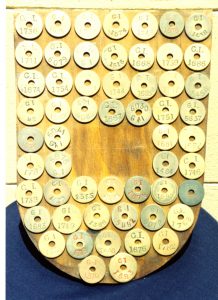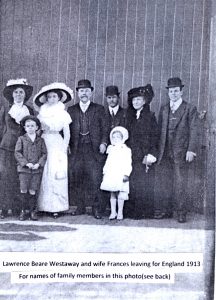- Author
- Rivett, Norman C
- Subjects
- Biographies and personal histories
- Tags
-
- RAN Ships
- None noted.
- Publication
- June 2014 edition of the Naval Historical Review (all rights reserved)
By Norman Rivett
During the period 9 February 1889 to 15 February 1991 at HM Naval Establishment Garden Island (later referred to as HM Naval Dockyard) there were, in addition to the Naval Engineer Managers, many civilian employees who rendered outstanding service to the Royal Navy and later the Royal Australian Navy.
Foremost amongst that number was Mr Lawrence Beare Westaway who was born at Meeth, Devon in 1853 and served an apprenticeship as an engine fitter at Henry Beares Engineering works at Liverton, Devon, a business which had been in the Beare family for three generations and was at the time of Lawrence’s employment owned by his Uncle Henry.
Lawrence’s father William worked for the firm the whole of his working life and his three sons successively joined him there. The firm had originally specialized in the manufacture of water mill wheels but no doubt diversified with the extension of the railway to the district. In 1880 Lawrence and his brother John went to work at Portsmouth Naval Dockyard: John subsequently transferred to Plymouth Naval Dockyard where Lawrence joined him some years later. It was from there that Lawrence elected to come to Garden Island.
Aged forty two, Lawrence sailed from Southampton on 23 August 1895 aboard the Orient Line steamship RMS Oruba bound from London to Sydney, with his wife Frances, son Lawrence James aged twelve years and daughter Florence Rosina aged ten years, where they arrived on 5 October 1895. In addition to the Westerway family there were five other second class passengers on board, these were Mr. J.L. Nott, Mr. G.N. Prince and daughter, Mr J.C. Bartholemew and Mr J.N. Alexander.
The five men were employees from HM Naval Dockyard Portsmouth and under contract to serve at HM Naval Establishment Garden Island for a period of five years. The group comprised an established Boilermaker, an established Engine Fitter, an established Coppersmith and an established Smith, i.e. an Engine Smith, with Mr L.B. Westerway as overseer of all departments as Acting Foreman of Fitters. An Established Tradesman was presumably the home dockyards equivalent to a Permanent Employee under the Naval Defence Act, a very desirable status and one which even some of Garden Island’s finest failed to achieve. The terms of their contract were as follows:
Articles of Agreement
Rate of Pay to be 10s per Diem for six days a week, and to be paid extra when employed beyond the working hours of the yard or on Sundays in accordance with the Regulations. To be allowed £30 per annum for house rent if not provided with quarters. He is to work according to the working hours of the Yard, and to be allowed half pay when hurt in the execution of his duty. He is to be allowed half pay for six days a week during his passage out and home.
He further agrees that he will be trained in the use of cannon and small arms, and will aid in the defense of Sydney Yard, or other place of his employment, and that he will not quit the Department he has engaged to serve in, during the period of danger or actual invasion, without a written discharge from the Head of the Department he may serve with.
He is perfectly aware that if he should be discharged for misconduct during the period for which he has engaged to serve at Sydney he will not be entitled to pay subsequent to the date of his discharge, nor under circumstances of aggravated misconduct, to a passage home at the expense of the Government. He is also aware that in the event of his being sent to hospital with any disease or injury resulting from his own default, he is to pay for subsistence at the rate of 2/6 per day, while under treatment.
If his conduct be reported satisfactory during the period of his service abroad he is to be re-entered in the (Home) Yard on his return at the expiration of this agreement.
He is to be examined and found medically fit.
The terms of the contract may appear harsh by modern standards but Mr Westerway certainly measured up to them for he continued to serve for eighteen years until his retirement on 24 August 1913 at age 60. During all this period the Westerway family lived in a cottage on Hill Road, then known as Signal Hill, Garden Island. The date of Mr Westerway’s retirement is significant for in addition to having reached the age of 60 it almost coincided with the previously agreed date of 1 July 1913 for the transfer of Admiralty assets to the Commonwealth of Australia and he may have considered his work completed. However due to uncertainty at the Admiralty regarding ownership of Garden Island and Admiralty House these assets were not transferred until 0930 on Monday 13 October.
Mr and Mrs Westerway returned to England aboard the P&O liner RMS Moldavia in 1913; whilst in England Mr Westerway was presented with the Imperial Service Medal (ISM) by HM King George V for his long and distinguished service (1880-1913). As both Mr and Mrs Westerway still had relatives in England they remained there for fourteen months before sailing for Australia on 5 October 1914, again on board RMS Moldavia. By then World War I had commenced so the return voyage would have been one of anxiety for their relatives in both countries.
The Westerways bought a house at Haberfield, Sydney to be near their married son and daughter and lived out their lives in quiet contentment. Lawrence Beare Westerway died at Haberfield in 1943 at the age of 90 and his wife Frances died less than a month later at the age of 88.
Evidence of Lawrence Westerway’s presence at Garden Island did not end with his retirement for the numbered brass docket system of time keeping which he introduced from the Home Dockyard continued in use until the early 1970s by which time security considerations required more positive identification.

Garden Island s first two apprentices started their apprenticeships in 1898 under the supervision of Mr Westerway; appropriately one of them was his son Lawrence James, an apprentice fitter who, continued to work at Garden Island for many years. The regulations governing the rates of pay for apprentices dated 5 April 1897 state: The term of apprenticeship was for six years and the daily rate of pay for the first year was eight pence, for the second year one shilling and one penny, the third year one shilling and four pence, the fourth year one shilling and eight pence, the fifth year two shillings and the sixth year two shillings and four pence.

An Admiralty Instruction dated 12 January 1909 amended the requirement for civilian employees to be trained in the use of cannon and small arms by stating: ‘The Admiralty considers it important that all British employees should be capable of using a rifle in case of necessity and approves facilities to join local Volunteer Forces and Rifle Clubs’. Interestingly Garden Island had an independent Volunteer Defense Corps during World War II before it was taken over by the Army and for many years after the war there was a Rifle Club which had a small bore rifle range behind Number 1 Boiler Shop.




